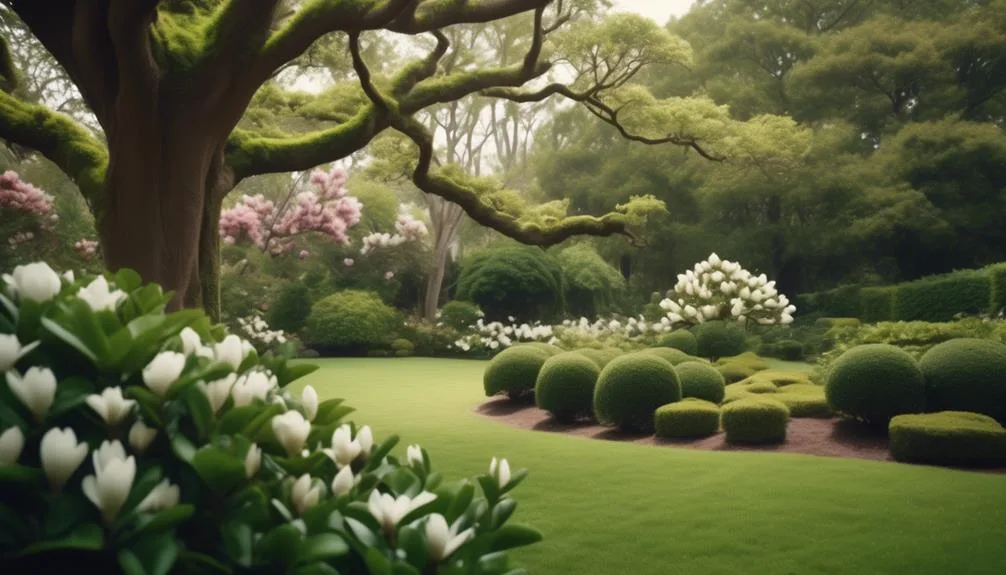Magnolia trees have been around for over 100 million years, making them one of the oldest flowering plants. If you're thinking about planting a magnolia tree near other trees, there are important things to consider.
Factors like ideal growing conditions, compatibility with other species, and potential issues can affect their coexistence. Understanding these dynamics is crucial for a healthy and beautiful landscape.
Let's explore how to successfully plant magnolia trees next to other trees for a thriving garden.
Ideal Growing Conditions for Magnolia Trees
To ensure the healthy growth of your magnolia trees, it's essential to provide them with the ideal growing conditions.
Magnolia trees thrive in slightly acidic to neutral soil with a pH level between 5.0 and 7.0. Ensure that the soil is well-draining and consistently moist, but not waterlogged, as excessive moisture can lead to root rot.
When it comes to sunlight, magnolia trees prefer full sun to partial shade. They generally require at least six hours of direct sunlight daily to bloom and grow optimally. However, in hotter regions, providing some afternoon shade can be beneficial.
Understanding and maintaining the appropriate soil pH and moisture levels, as well as ensuring adequate sunlight and shade, will contribute significantly to the flourishing of your magnolia trees.
Compatibility of Magnolia Trees With Other Species
Magnolia trees can be compatible with a variety of other species in your garden, adding diversity and enhancing the overall aesthetic appeal of your landscape. When considering tree compatibility, it's essential to choose coexisting species that complement the magnolia's needs.
For instance, underplanting with low-growing perennials can create a harmonious environment for the magnolia tree's shallow roots. Additionally, selecting trees with similar water and sunlight requirements can promote a thriving ecosystem. When choosing coexisting species, consider factors such as soil pH, drainage, and space requirements.
Some suitable companions for magnolia trees include dogwoods, azaleas, and rhododendrons, as they share similar soil and light preferences. By carefully selecting coexisting species, you can create a visually stunning and ecologically balanced garden that supports the growth of your magnolia trees.
Potential Issues When Growing Magnolia Trees Near Other Trees
When growing magnolia trees near other species, it's important to be aware of potential issues that may arise due to differences in soil pH, water and sunlight requirements, and space considerations.
Magnolia trees have strong, spreading root systems that can potentially compete with other trees for nutrients and water. This competition can affect the growth and health of both species.
Additionally, magnolia trees are known for their preference for well-drained, slightly acidic soil, which may differ from the requirements of neighboring trees.
Moreover, the shade tolerance of magnolia trees needs to be considered, as they may outcompete other trees for sunlight.
While some trees can share nutrients through interconnected root systems, others may not, leading to potential nutrient sharing issues.
Therefore, careful planning and consideration of these factors are essential when planting magnolia trees near other species.
Tips for Planting Magnolia Trees Alongside Other Trees
Consider the specific sunlight and soil needs of both magnolia trees and the other species when planning their placement together. To ensure successful growth, follow these tips for planting magnolia trees alongside other trees:
- Tree Spacing: Provide enough space between magnolia trees and other species to prevent overcrowding and competition for resources. Aim for at least 15 feet of space between mature trees.
- Root Competition: Be mindful of potential root competition between magnolia trees and other species. Plant them at a distance from each other to minimize root interference and allow for healthy growth.
- Soil Considerations: Assess the soil conditions to ensure they meet the requirements of both magnolia trees and the other species. Make any necessary amendments to the soil to accommodate the needs of both types of trees.
- Sunlight Exposure: Take into account the sunlight requirements of each species when selecting their planting locations to ensure they receive adequate sunlight for optimal growth.
Best Tree Companions for Magnolia Trees
To ensure successful growth when planting magnolia trees alongside other species, it's essential to consider the best tree companions for magnolia trees. When selecting companions for magnolia trees, prioritize species that have similar soil compatibility to reduce root competition.
Additionally, opt for trees with shade tolerance to thrive alongside the magnolia's canopy. Some suitable options for companion trees include dogwood, redbud, and serviceberry, as they not only complement the magnolia's aesthetic appeal but also have comparable soil and shade requirements.
These companions can also aid in nutrient sharing, contributing to the overall health and vigor of the magnolia tree. By choosing tree companions with these characteristics, you can create a harmonious and mutually beneficial environment for your magnolia tree to flourish alongside other trees in your landscape.
Conclusion
In gardening, the right companions and care can help magnolia trees thrive alongside other species.
By being mindful of potential issues and following planting tips, your magnolia trees can flourish in their new environment.
Consider the implications of creating a harmonious ecosystem and the lasting impact of thoughtful planting choices.
Happy gardening!

My interest in trees started when I first saw the giant sequoias in Yosemite.
I was a teenager then, and I remember thinking, “I need to learn more about this.”
That moment stuck with me.
A few years later, I went on to study forestry at Michigan Tech.
Since graduating, I’ve worked in a mix of hands-on tree care and community education.
I’ve spent over ten years helping people understand how to plant, maintain, and protect the trees in their neighborhoods.
I don’t see trees as just part of the landscape.
They are living things that make a real difference in our daily lives.
